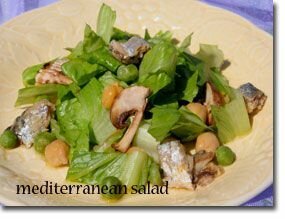Today's Recipe
If you don't know what to serve for dinner tonight ...
Salad lunches are popular along the Mediterranean. They make a
complete meal that will carry you through until dinner. The combination
of ingredients in this salad can be changed to suit your personal taste.
Enjoy!
Mediterranean-Style Salad

Prep and Cook Time: 10 minutes
Ingredients:
- 6 cups chopped romaine lettuce
- 1/3 of a 3.75 oz can sardines, packed in water
- 1/4 cup crimini mushrooms, sliced
- 1/2 cup cooked garbanzo beans or canned (no BPA)
- 1/4 cup frozen peas
- Dressing
- 1 TBS exra virgin olive oil
- 1 clove garlic, chopped or pressed
- 1 tsp lemon juice
- Place lettuce in large bowl and top with remaining ingredients and dressing.
In-Depth Nutritional Profile for Mediterranean-Style Salad
Healthy Food Tip
Can you tell me about amaranth?
Amaranth has always had a place near and dear to my heart. Years ago, I heard about amaranth, the grain that had once been a staple in the diets of pre-Columbian Aztecs. I had learned that with the arrival of Cortez and the Spanish conquistadors, all crops of amaranth were burned, its use was forbidden, and its possession was cause for severe punishment. I set out to find this "lost" grain, to hopefully discover this treasure that lay at the heart of this incredibly powerful people.
After 300 years of it being in obscurity, I rediscovered amaranth in Mexico where I was honored to share it on ceremonial days with the descendents of the Aztecs, who believed that amaranth provided them with supernatural power. Therefore, it is not surprising to me when people say they are not familiar with amaranth as it was only in the 1970s that I reintroduced this ancient grain to the United States.
Amaranth is a moderately tall, broad-leafed, bushy type of plant that grows about six feet in height and produces a brightly colored flowery head containing a very large number of seeds. (Amaranth plants can produce as many as 60,000 seeds.) These seeds are the amaranth grains found in amaranth cereal and flour. Amaranth is a member of the Chenopodiaceae family of plants and therefore is a relative of beets, Swiss chard, spinach, and quinoa. For this reason, some of its nutritional characteristics are more like these dark green leafy vegetables than the cereal grain foods, which are members of an entirely different plant family, called Graminae. (Like, quinoa and millet, amaranth is not technically a grain, but because it is enjoyed in meals like other true grains, it is usually referred to as such.)
When it comes to a good number of nutrients, including numerous vitamins, minerals, and amino acids, amaranth is very similar to other grains (like wheat) as well as to other green leafy vegetables (like Swiss chard). However, I'd point to four nutrients as being significantly different when it comes to amaranth.
First is the amino acid lysine. Most cereal grains, like wheat, are relatively low in this amino acid. Alternatively, amaranth is relatively rich in this amino acid, containing approximately twice as much lysine as wheat on an ounce-for-ounce basis. Next are the minerals calcium, iron, and magnesium. In this mineral area, amaranth is much more like Swiss chard than wheat. It contains about four times as much calcium as wheat and twice as much iron and magnesium.
Amaranth can be simmered like other grains and has a porridge-like texture. It can be combined with other grains if you desire a more "rice-like" dish. It can also be popped in a skillet like popcorn, which gives it a nutty flavor and crunchy texture.
The reason I didn't include amaranth as one of the featured World's Healthiest Foods is because it is not as widely available as the other grains that I did include. Yet, I think that it is a very valuable nutrient-rich food and I encourage you to enjoy it as part of your Healthiest Way of Eating.
Reference:
US Department of Agriculture. (2006). National Nutrient Database for Windows, Version 1.0 (SR 19). Nutrient Data Laboratory, Beltsville Human Nutrition Research Center, Beltsville, MD.



No comments:
Post a Comment